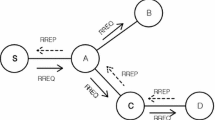Abstract
This paper aims to provide a complete security mechanism for DOS attacks in wireless networks. Various techniques and methodologies were proposed in the earlier studies against DOS attack and their solution in terms of detection and prevention rate is very less. In this paper DAD-(defending against DOS) approach is proposed to provide maximum level of security and DAD shows the efficiency in terms of detection and prevention. DAD has two main phases, such as authentication and monitoring. In authentication phase entire node verification and certification is provided by DAD approach. In monitoring phase the entire traffic flow is monitored with a help of USIP-recording and USIP-marking methods. The simulation result shows that the efficacy of DAD is better than the existing approaches in terms of detection and prevention.











Similar content being viewed by others
Abbreviations
- BS:
-
Base station
- RH:
-
Region head
- TMA:
-
Traffic monitoring agent
- AD:
-
Administrator node
- Ni :
-
Node i
- G:
-
Network G
- NID:
-
Node-identification
- USIP:
-
Unique static IP
- Auth-Key:
-
Authentication key
- M:
-
M number of nodes
- RID:
-
Region identification
References
Fatima, S. G., Sattar, S. A., & Anitha Sheela, K. (2014). Energy efficient intrusion detection system for wireless sensor network using neural network. Journal of Theoretical and Applied Information Technology, 59(2), 352–359.
Agarwal, S., Jain, V., & Goswami, K. (2014). Energy efficient mac protocols for wireless sensor network. International Journal on Computational Sciences & Applications (IJCSA), 4(1), 153–160.
Wang, Y., Fu, W., & Agrawal, D. P. (2013). Gaussian versus uniform distribution for intrusion detection in wireless sensor networks. IEEE Transactions on Parallel and Distributed systems, 24(2), 342–355.
Sun, B., Shan, X., & Wu, K. (2013). Anomaly detection based secure in-network aggregation for wireless sensor networks. IEEE Systems Journal, 7(1), 13–25.
Liu, B., Dousse, O., Nain, P., & Towsley, D. (2013). Dynamic coverage of mobile sensor networks. IEEE Transactions on Parallel and Distributed systems, 24(2), 301–311.
Lee, Y.-J., Yeh, Y.-R, & Wang, Y.-C. F. (2013). Anomaly detection via online oversampling principal component analysis. IEEE Transactions on Knowledge and Data Engineering, 25(7), 1460–1470.
Shan, Z., Wang, X., & Chiueh, T. (2013). Malware clearance for secure commitment of OS-level virtual machines. IEEE Transactions on Dependable and Secure Computing, 10(2), 70–83.
Tartakovsky, A. G., Polunchenko, A. S., & Sokolov, G. (2013). Efficient computer network anomaly detection by changepoint detection methods. IEEE Journal of Selected Topics in Signal Processing , 7(1), 4–11.
Wei, W., Chen, F., Xia, Y., & Jin, G. (2013). A rank correlation based detection against distributed reflection DoS attacks. IEEE Communications Letters, 17(1), 173–175.
Wang, X., Xu, Y., Jiang, J., Ormond, O., Liu, B., & Wang, X. (2013). StriFA: Stride finite automata for high-speed regular expression matching in network intrusion detection systems. IEEE Systems Journal, 7(3), 374–384.
Chen, Y., Ma, X., & Wu, X. (2013). DDoS detection algorithm based on preprocessing network traffic predicted method and chaos theory. IEEE Communications Letters , 17(5), 1052–1054.
Al-Hamadi, H., & Chen, I.-R. (2013). Redundancy management of multipath routing for intrusion tolerance in heterogeneous wireless sensor networks. IEEE Transactions on Network and Service Management, 10(2), 189–203.
Bhoopathy, V., & Parvathi, R. M. S. (2012). Securing node capture attacks for hierarchical data aggregation in wireless sensor networks. International Journal of Engineering Research and Applications (IJERA), 2(2), 466–474.
Fulare, R. P., & Sakhare, A. V. (2014). Secure authentication technique in wireless integrated sensor network: Virtual certificate authority. International Journal of Application or Innovation in Engineering & Management (IJAIEM), 3(3), 152–160.
Chen, I.-R., & Wang, Y. (2012). Reliability analysis of wireless sensor networks with distributed code attestation. IEEE Communications Letters, 16(10), 1640–1643.
Fung, C. J., Zhang, J., & Boutaba, R. (2012). Effective acquaintance management based on bayesian learning for distributed intrusion detection networks. IEEE Transactions on Network and Service Management, 9(3), 320–332.
Wang, C., Feng, T., Kim, J., Wang, G., & Zhang, W. (2012). Catching packet droppers and modifiers in wireless sensor networks. IEEE Transactions on Parallel and Distributed Systems, 23(5), 835–843.
Wang, G., Yu, J., & Xie, Q. (2013). Security analysis of a single sign-on mechanism for distributed computer networks. IEEE Transactions on Industrial Informatics, 9(1), 294–302.
Gong, C., & Sarac, K. (2009). Toward a practical packet marking approach for IP traceback. International Journal of Network Security, 8, 271–281.
Merton, R. K. (1968). The Matthew effect in science: The reward and communication systems of science are considered. Science, 159(3810), 56–63.
Yan, D., Wang, Y., Su, S., & Yang, F. (2012). A precise and practical IP traceback technique based on packet marking and logging. Journal of Information Science and Engineering, 28, 453–470.
Rajkumar, D. U. S., & Vayanaperumal, R. (2013). A leader based monitoring approach for sinkhole attack in wireless sensor network. Journal of Computer Science, 9(9), 1106–1116.
Author information
Authors and Affiliations
Corresponding author
Rights and permissions
About this article
Cite this article
Thomas Paul Roy, A., Balasubadra, K. DAD: A Secured Routing Protocol for Detecting and Preventing Denial-of-Service in Wireless Networks. Wireless Pers Commun 90, 457–471 (2016). https://doi.org/10.1007/s11277-015-3022-x
Published:
Issue Date:
DOI: https://doi.org/10.1007/s11277-015-3022-x




